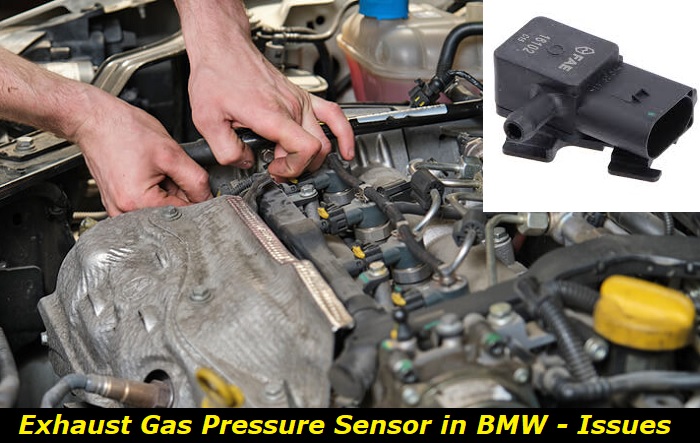The exhaust back pressure sensor is a little component that tracks pressure changes in the exhaust system. Symptoms of a faulty exhaust back pressure sensor failure in BMW include decreased fuel efficiency, sputtering and stalling engine, an illuminated check engine light, and more emissions.
Engine sensors problems highlights
- DIY repairs:possible
- Tools needed:scanner,basictools
- Commonreasons:sensor problems, electric supply issues, software glitches
- Time to repair:1 - 2.5 hours
- Price for parts:$50 - $250
- Can you drive?In most cases, yes
- Alternative solutions:bypassing, driving in limp mode, roadside assistance

What is the Exhaust Back Pressure Sensor?
Before we tell you about the sensor, the exhaust back pressure is the amount of pressure required to expel the gasses emitted by your engine.
The word "back" does not imply the direction of the pressure. Pressure is a scalar quantity. This means it has no apparent direction. Exhaust gasses can only move from an area with high pressure (inside the engine) to an area with low pressure (the atmosphere)
The exhaust back pressure sensor (EBP sensor) is a small electrical component found in the exhaust system of a vehicle. Its work is to record pressure levels within the exhaust system. The EBP sensor relays the pressure information to the engine control module (ECM) for a better engine which will then control the engine based on the information provided. However small the sensor is, it is a crucial part of the performance of your engine.
The work of the exhaust back pressure sensor boils down to three aspects: efficiency, performance, and emissions. A faulty sensor will mean your engine will exhibit reduced performance and more emissions.
Symptoms of a Faulty BMW Exhaust Back Pressure Sensor
Some symptoms of a faulty BMW EBP sensor:
- Sputtering and Stalling Engine
A sputtering and stalling engine is perhaps the worst symptom of a faulty EBP sensor. Apart from the frustrations it can cause, this symptom is a potential safety hazard.
- Reduced Engine Power and Acceleration
As a BMW owner, you may have noticed something off about your beloved ride. The acceleration has drastically reduced. You may have also noticed that the BMW is struggling to achieve its usual top speed.
While many factors could lead to reduced engine power and acceleration, one culprit should never be overlooked: a malfunctioning exhaust back pressure sensor.
- Illuminated Check Engine Light
Your BMW is more intelligent than you may think. It has an advanced onboard diagnostics system that will quickly detect any error in the system. The Check Engine Light (CEL) is a way for the vehicle to relay information to the user that there is an issue that demands to be sorted out urgently. The CEL will turn on if there is a problem with your vehicle's exhaust system, ignition, and fuel. If you value your car, the CEL light is not something to take lightly.
Many malfunctions can result in an illuminated check engine light. Therefore, this symptom does not necessarily imply a faulty exhaust back pressure sensor. The best part is that with a CEL light, your BMW has an advanced self-diagnostic system that logs the problem. So, your part is to take your BMW to a trusted mechanic who can read the error code and determine the issue.
- Decreased Fuel Efficiency
Another symptom that could indicate a faulty exhaust back pressure sensor is a decrease in fuel efficiency. The EBP sensor provides data to the ECU. This data is used to control fuel injection. If the sensor is faulty, this coordination is disrupted. As such, you will end up with excessive fuel consumption.
- Increased Emissions
With more fuel consumption and decreased efficiency, you should expect increased emissions. Have you noticed that your BMW is producing noticeably more exhaust fumes? Well, that could be a sign of a malfunctioning EBP sensor.
This happens because the faulty sensor cannot accurately figure out the exhaust back pressure. Consequently, the Engine Control Unit will misread the engine's fuel needs. The inefficiency often results in increased carbon emissions. If you love the environment, a faulty exhaust back pressure sensor should never be part of your BMW.
Common Causes of BMW Exhaust Back Pressure Sensor Failure
There are many causes of a faulty exhaust back pressure sensor. Here are some potential causes of a BMW exhaust back pressure sensor failure:
1) Poor Quality Fuel
There is no doubt that your BMW loves premium fuel. In essence, higher quality fuel has more octane rating. Such fuel can withstand higher compressions before igniting. Most BMW engines are designed to work with premium fuel.
The additional cost you will incur to pay for premium quality fuel is a small price to pay if you value your car. What happens when you use lower-quality fuel is that your engine has to overwork to compensate for the low-quality fuel.
It is essential to comprehend that lower-quality fuel does not directly harm your EBP sensor. Instead, the EBPS system can suffer from engine misfires and carbon deposits resulting from low-quality fuel.
2) Clogging of Exhaust System
A clogged exhaust system can be a result of many things. The buildup of carbon deposits, rust, and foreign objects are popular occurrences. As explained earlier, the EBPS system measures the pressure within the exhaust system and relays the information to ECM. A clogged exhaust system will increase the backpressure within the system and thus the EBPS will relay inaccurate readings.
Ways to Fix a Faulty BMW Exhaust Back Pressure Sensor
Identifying the symptom is winning half the battle. The other half lies in solving the identified problem.
Here are some ways to fix a faulty BMW Exhaust Back Pressure sensor:
1) Cleaning the Exhaust System
Cleaning the exhaust system can resolve the problem. The process is somewhat simple. It does not require any technical skills or sophisticated tools. However, you may need to raise the vehicle to access the exhaust system. In most BMWs and other car models, the sensor is attached to the exhaust pipe.
You should also take the opportunity to check for any visible signs of damage, blockages, and loose connections. You can use any electrical component cleaner to get the job done. For the tip of the sensor, use a soft brush to brush off debris and dirt. When done, replace the sensor and make sure you reconnect the electrical connector as it was.
2) Replacing the Exhaust Back Pressure Sensor
If cleaning fails, there is a high chance that the exhaust back pressure sensor is damaged and needs to be replaced. Fortunately, the EBP sensors are available for sale and you can acquire one with ease.
The process requires simple tools such as wrenches, pliers, and even a multimeter for testing. Just like when cleaning, the process is pretty straightforward. Get beneath the car, locate the sensor, disconnect the electrical connectors, and remove the sensor careful not to damage anything.
Before you install the new sensor, take the chance to clean the exhaust system and inspect it for damages and anything that shouldn't be there. Next, install the new sensor being careful not to over-tighten the screws as you can damage the mounting surface.
Lastly, start the car and take it for a test ride to observe if the problem has been resolved.
3) Regular Maintenance of the Exhaust System
If you value your BMW, you should make it a regular habit to regularly take your car for service. Even if you can't drive it to a mechanic, you can still perform several maintenance routines that do not require specialized tools and skills. With the exhaust system, the best you can do to avert future disappointments is to clean it.
Lastly, did you know that driving your car is part of maintenance? Regularly drive it at highway speeds to clean the exhaust system. Driving it regularly also prevents the accumulation of carbon deposits, debris, and rust.
Conclusion
To that end, I hope you can now identify the symptoms of a faulty exhaust back pressure sensor in your BMW. The EBP sensor plays a critical role in the smooth operation of your engine.
A faulty sensor isn't something to ignore. Even if you do not know that the exhaust back pressure sensor is malfunctioning, you will surely know that something is off with your BMW. Once you are certain that your BMW has a faulty EBP sensor, there are two things you can do. You can clean it carefully and put it back. If it doesn't work after you clean it, the sensor may be permanently damaged. In that case, get a new sensor.
Most importantly, regular maintenance is the key to prevent the symptoms from interfering with your ride. If you aren't sure about anything, do not risk doing it on your own. Instead, drive your BMW to a trusted mechanic to help you check it out.
About the authors
The CarAraC research team is composed of seasoned auto mechanics and automotive industry professionals, including individuals with advanced degrees and certifications in their field. Our team members boast prestigious credentials, reflecting their extensive knowledge and skills. These qualifications include: IMI: Institute of the Motor Industry, ASE-Certified Master Automobile Technicians; Coventry University, Graduate of MA in Automotive Journalism; Politecnico di Torino, Italy, MS Automotive Engineering; Ss. Cyril and Methodius University in Skopje, Mechanical University in Skopje; TOC Automotive College; DHA Suffa University, Department of Mechanical Engineering






Add comment